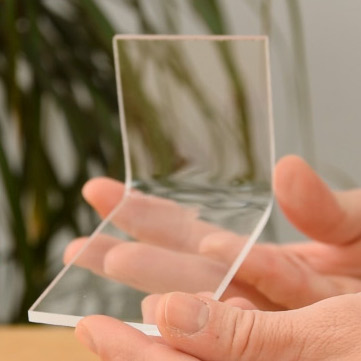The most efficient method of bending PERSPEX® sheet is described from Gerald Bell's blog
Because heat softens PERSPEX® without affecting its color, bending it opens up a world of possibilities. Now you can make gorgeous transparent PERSPEX® or colorful PERSPEX® cabinets as well as handy laptop or tablet holders with this innovative technology. We've compiled a list of the most important bending acrylic sheet tips and tricks for this site.
Working using PERSPEX® flexible sheet
Both cast acrylic and extruded acrylic (the cheaper version) may be bent easily. Excellent outcomes can be achieved with practice and preparedness! Professionals and adept DIYers alike can start bending acrylic using a paint burner, a heat spiral, or a convection oven. Be sure to remove the protective foil from both sides of the acrylic sheet before folding. To avoid overheating the PERSPEX®, it must be closely monitored while being heated.
Heat bending PERSPEX®

To bend PERSPEX® (acrylic sheet), professionals utilize a filament or resistance wire bending jig. They bend the acrylic sheet exactly above the wire, as indicated in the illustration. Acrylic softens and bends easily when heated to 160°C. Caution is advised. Slowly bending the acrylic prevents tearing the material on the exterior of the fold. After acrylic bending, heat the outside of the fold line for a few seconds to seal it. Allow the PERSPEX® to cool and firm before moving on to the next stage. After cooling, PERSPEX® keeps its new shape eternally.
Bend an acrylic sheet with a hairdryer.
If you don't have a filament or heating coil, a hairdryer, an adjustable paint burner, or a convection oven will do. In these settings, the acrylic sheet becomes more flexible over a broader surface area.
Here are some tips for bending PERSPEX® with a heat gun or a hairdryer:
Heat the panel and remove the protective coating from both sides.
When using a hair dryer, keep the outflow hole at least 5 cm away from the surface of the acrylic sheet.
Gently run your hair dryer along the fold line, making sure it warms evenly.
Regularly pulling lightly on the acrylic sheet's edge to test for flexibility is advised.
When bending acrylic, use a batten at the fold line to achieve a straight fold.
Using a convection oven to bend PERSPEX®
Depending on the application, a convection oven can potentially soften and bend PERSPEX®. Making acrylic napkin rings with a convection oven is straightforward, as shown in this DIY: Making an acrylic bowl.
Here are some tips for using a convection oven:
Instead of a grid, place the acrylic sheet on a flat, heat-resistant tray.
Preheat the oven with the baking tray, and let it heat up slowly.
Remove the acrylic sheet from the oven for 4–5 minutes after reaching the desired temperature (160°C). Thinner sheets (up to 5 mm) will be easier to bend because they will be ready faster.
The acrylic sheet can be folded in half along a batten by letting it lie on top of the heat-resistant tray.

Keep the PERSPEX® in the appropriate form until it has cooled fully. It will now stay in the desired shape without reversing.
On the web, you can get more inspiration for bending acrylic sheet.
The possibilities are nearly unlimited once acrylic bending is mastered. For inspiration, how about a transparent bedside table or a DIY tablet holder? PERSPEX®® may be bent to make various furniture and other products. More ideas can be found in our blog.
Buying bendable PERSPEX®
Do you want to start bending PERSPEX®? Simply order PERSPEX® sheets online and we will cut them to your specifications at no extra charge. We provide a wide range of PERSPEX® sheets, from clear to bright and colored. We will do our best to deliver your purchase as soon as possible. For questions or recommendations concerning bending PERSPEX®, contact us. Please contact us.

The Wall